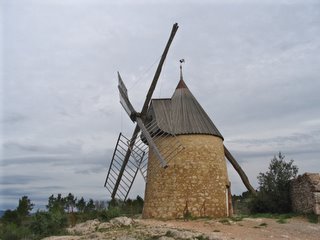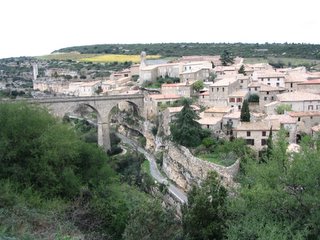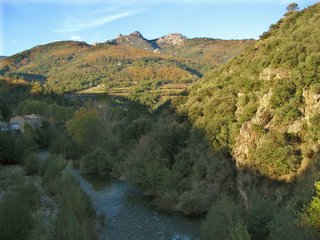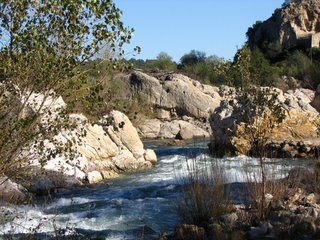A trip into St. Chinian was required this morning to top up supplies at the Supermarket. The Mediterranean lunch hour extends to at least three hours normally, and things are rarely normal, so it was essential to arrive before 11am at the latest.
We have been here nearly a week and, seduced by the many things the area has to offer, we had not yet started on our investigation of the Cathars, one of the main objectives for being here. (At least for Ian, for Jill it has more to do with “Appelation d’Origine Controlée” and names with which she had become familiar from shopping regularly in the Exeter supermarkets’ wine department - Corbière, Minervois, St. Chinian, Hérault and Pays d’Oc to name a few around here.)
So after lunch we drove off into the hills beyond St. Chinian along pictureque, deserted roads through hectares of golden red vineyards surrounded by bleached, arid hillsides. We passed a wonderful windmill overlooking St. Chinian, with nice views back over the town. Presumably used for grinding or pressing olives, but possibly for pumping water, it stood on an isolated rocky bluff amidst huge agaves, scrubby low bushes, wiry grasses and fruiting juniper bushes. All plants around here are hardy, strong and able to survive both the harsh heat of the sun and the lack of regular water, retaining a foothold into the stony ground as best they can.
 Windmill above St. Chinian
Windmill above St. Chinian Windmill above St. Chinian
Windmill above St. ChinianOur target this afternoon was Minerve, a Cathar town close to Ambre. Perhaps a few works of explanation about the Cathars is called for. Now relegated to a footnote in history they were in the 12th century a religious movement that threatened to create a faith to rival the Catholic Church and Islam in the south west of Europe. For some reason the beliefs struck a chord in the Occitan mentality, especially in the Languedoc, and there were many thousands of adherents to this creed, with its belief in the duality of good and evil forces embodied in God and Satan, each with equal powers in the scheme of things. The evil principle was embodied in all physical created matter and only spiritual things reflected the positive side of the universe. Thus the world and the flesh were the work of the Devil. The Old Testament was rejected and Christ was seen not as an incarnation but as a spiritual being. They also rejected the mass, relics, indulgences and all the trappings of Catholic practice - indeed the discontent fed by the heavy demands of a church run by wealthy and often dissolute prelates may have assisted the spread of the heresy. The Cathars also believed in the transmigration of souls. The elite believers, known as “parfaits” abstained from flesh, eggs, cheese and marriage. Other believers, the “croyants” were free to live more normal lives, the only sacrament being the “consolamentum” achieved by a “parfait” laying his hands on the believer, normally when close to death, after which the consoled person was to take no further food and effectively starve to death.
Preoccupied by the crusades in the Holy Land, the Papacy tried persuasion to overcome this heresy but, after his legate Peter de Castelnau was murdered in 1208, Pope Innocent III declared a crusade against the Albigenses, as the Cathars were also named, from the town of Albi where they were particularly numerous. The resulting campaign lasted until 1223 and was accompanied by extreme cruelty and oppression. The crusading knights, mainly from the north of France, who were led by Simon de Montfort, attacked and pillaged most of the towns and strongholds of the Cathars in the Languedoc. The Holy Inquisition was established in 1233 using the Dominicans and Franciscans to root out heretics. The Count of Toulouse, who was sympathetic to the Cathars was eventually forced to cede his domains to the French crown. The flourishing culture of Occitan was dealt a severe blow by these events.
The last flickering of Cathar life was to be found in the mountainous areas in the far south of the Languedoc where the minutely detailed records of an inquisitorial court at Pamiers between 1318 and 1326 provide the source material for the fascinating account of the everyday life of the medieval peasant that Emmanuel Le Roy Ladurie has given us in his study Montaillou.
This very sketchy outline may provide helpful background for those who, like Jill, knew virtually nothing of the Cathars and their history, thinking they had something vaguely to do with the Knights Templar and the search for the Holy Grail. There really is so much to learn concerning every aspect of this area - history, geography, geology, fauna and flora and its present day economy as one of the major wine growing areas of France.
The view of Minerve as we rounded the bend on the far side of the river Cesse and looked down upon the village - it really is no more than that - was stunning. Over thousands of years the bubbling little river has scoured a deep gorge through the Causse (desolate arid limestone plateau), even forming natural tunnels through the rocks. Some of the dwellings in the area are troglodyte, being built directly into the sides of the gorge. The village itself is a network of narrow cobbled streets running between a jumble of pink stone houses perched on top of the cliffside high above the river and accessed via a narrow, multi-arched bridge across the ravine. The remains of castle walls dominate the narrow neck of rock on which Minerve sits where the rivers Cesse and Brian join. In the centre is the church with memorials to the capture of Minerve by Simon de Montfort in 1210. More than 140 Cathars who had been offered shelter by the town and had refused to foreswear their beliefs were burned alive for their faith.
Jill now suggests you select a bottle of Minervois wine from your supermarket, a deeper red than even the blood of the martyred Cathars, and join us from wherever you are, in enjoying a wonderful glass of bottled sunshine as you view our pictures of where it came from!
 First glimpse of Minerve
First glimpse of Minerve Footbridge across the ravine to Minerve
Footbridge across the ravine to Minerve Church square with memorial to the Cathars burned at Minerve in 1210
Church square with memorial to the Cathars burned at Minerve in 1210 Minerve from the west showing the gorges on either side
Minerve from the west showing the gorges on either side South Postern at Minerve
South Postern at Minerve Barbican gate above the river at Minerve
Barbican gate above the river at Minerve Natural bridge through the cliffs formed by river Cesse beneath Minerve - we could dimly see daylight at the end of this tunnel!
Natural bridge through the cliffs formed by river Cesse beneath Minerve - we could dimly see daylight at the end of this tunnel! The gorge of the Cesse at Minerve
The gorge of the Cesse at Minerve Gorge of the River Brian at Minerve
Gorge of the River Brian at MinerveWe later continued to the tiny circular town of Aigne. Built for defence in the 11th century it is in the form of a “circulade” also descriptively termed an “escargot” or snail as the cramped narrow streets spiral gradually in towards the Romanesque church in the centre with its small square, which would form the final refuge in times of conflict. It was like stepping back through history to see this unusual layout preserved in this way for a thousand years, its external walls forming a complete circular shell protecting the “escargot” within.
 Outer shell of “escargot” at Aigne.
Outer shell of “escargot” at Aigne.The best we could do. The curve of the old buildings reflects the circular street layout within
On our way home we stopped to give the helpful garagiste a bottle of Pernod for his trouble yesterday. Whether he drinks the stuff we don’t know but his delighted smile showed he was pleased we’d thought.
 Vinyards on the Causse on our way home
Vinyards on the Causse on our way homeMonday 7th November 2005, Ambre-les-Espagnolettes
On Saturday we visited the little town of Olargues up in the mountains to the north some forty kilometres from here. It happened to be the day of their chestnut fair and the new wine but you can never have too much of a good thing so we were able to wander the steep narrow streets of what is classified as one of the most beautiful villages of France, clutching newspaper cones of hot chestnuts to enjoy as we scrambled up through stony crumbling terraces of ancient dwarf oaks to enjoy windy views of the village and the surrounding green-grey mountainside from the base of the ruined mediaeval castle. The keep is now used as the bell tower for the church way below it in the village. Below Olargues a twelfth century single, slender arched bridge, the Pont du Diable, links the village to the road along the gorge of the river Jaur which runs into the Orb a few kilometres to the east.
 Castle keep at Olargues
Castle keep at Olargues The tiny town of Olargues
The tiny town of Olargues Pont du Diable, Olargues
Pont du Diable, Olargues View from the Pont du Diable, Olargues
View from the Pont du Diable, OlarguesYesterday was very different with a sense of the surreal. One willingly accepts that every day brings new surprises when travelling as we are and it was with a sense of delight and curiosity that we joined a group of some twenty resident British people, for a Sunday lunch party fifty or sixty kilometres from here, just north of Bédarieux. The invitation had appeared in our email a couple of days ago from Chris and Mostyn who have retired here from the University of Exeter. Although we had never met them, we have a mutual friend, Helen, who had mentioned that our travels had brought us to the Béziers area.
Their home lies just outside the village surrounded by fields, apple orchards and woodland that came with the house, their property stretching to the banks of the river Orb. Whether Mostyn uses his fishing and hunting rights we don’t know, certainly there are trout in the river and apparently wild boar in the surround hills. The view from the terrace and swimming pool is of the open valley stretching to the nearby hills. They have lived here for a couple of years now and seem blissfully happy with their new life though, in common with most of the British guests we met, have found mastering the language and integrating easily with the local French people very difficult. (Not helped by the heavy Occitan accent that even the Northern French find difficult to follow). A number of the other guests were originally from Devon - Exeter, Poltimore, Totnes and Chagford! We had no idea such a contingent of Devonians thrived in the South of France! Modestine almost brought tears of nostalgia to the eyes of one couple who had previously owned a Romahome and were delighted just to go and sit reminiscing in her for a while. Meanwhile, someone we assumed was from the party came up to ask if he could see inside as well. It turned out he was a neighbour who was simply passing with his French wife, and had once seen a Romahome locally and had longed to own one ever since. He was really excited about her and thinking we lived here invited us to visit his family at the nearby riding school they ran! They joined Chris and we ended up chatting in a mixture of French and English, the outcome of which is that our hosts have made new friends and are invited for an aperitif on Tuesday! Modestine certainly opens doors!!
The date may have been 6th November but the sky was a brilliant clear blue and the sun was hot and bright on the terrace. We drank the local wine and enjoyed a wonderful buffet lunch of all the good things to be found in France presented in a very English atmosphere. We even had trifle, fruit crumble, lemon meringue pie and earl grey tea! It was a wonderful afternoon and really nice to meet so many “Brits” happy with their new lives here. It is easy to understand why, though we admire their courage in burning their boats for a new life they cannot be certain will work out as they expect.
Dusk was falling as we left and we had to drive home through the twisting mountain roads. The autumn festival was under way at Bédarieux with thousands of vehicles streaming into town and total mayhem with parking once they arrived. It was not pleasant driving strange, unlit steep twisting roads against the glare of their headlights and we were very relieved to reach home safely. Night driving is to be avoided whenever possible.
Tuesday 8th November 2005, Ambre-les-Espagnolettes
Today we bought kaki fruit. Funny taste but we are determined to try almost anything at least once. We have seen them growing in the village near here, along with pomegranates. We think kaki fruits are actually the same as custard apples as sold in UK supermarkets around this time of year, but these are much bigger. Bright orange they taste like nothing we’ve ever eaten before. If you’ve not yet tried them, go and buy one.
Yesterday we set off for Béziers with a view to posting up another web page as the only possibility locally is currently only open once a week. The sun was warm, hot even and we easily became side-tracked. We stopped for a picnic lunch beside the river Orb at Le Moulin de la Roque. At this point the translucent green river tumbles in a series of white foaming cascades through a jumbled mass of white boulders - le Chaos de Réals and in the shallows at the water’s edge we watched a heron fishing. Against this background the tree covered hills rose up to a sky of brilliant blue where a buzzard gradually wheeled higher and higher. On the opposite bank, perched on the rocks, stood the remains of an old water mill - the Moulin de la Roque. Although obviously a popular resort in summer, particularly for kayaking, the area was practically deserted and life seemed quite perfect as we explored the river bank and scrambled amongst the rocks. The river was flowing with great speed through the series of tumbling rapids and there was evidence that flooding is common with tangles of roots and grasses high in the branches of the trees along the banks.
 The river Orb at Le Moulin de la Roque
The river Orb at Le Moulin de la Roque Chaos de Réals
Chaos de RéalsOf course nothing is perfect. It appears to be a popular area for people to exercise their large dogs, as we discovered to our cost when we found large smelly blobs all over Modestine’s floor and Jill’s shoes! French friends recently told us that they had read an offensive article about the British saying the French are filthy. We are complete Francophiles and try to be positive about everything but we cannot deny that the South of France has a very different perception to public hygiene than the British and we have a grudging agreement with the newspaper article. Last night saw us at our village lavoir (communal washing place with large sinks found in many old villages throughout France but generally no longer in active use) with scrubbing brush, rubber gloves and large bottle of disinfectant, washing Modestine’s carpets!
Once things go pear-shaped they tend to stay that way. When we eventually reached Béziers it was to discover we’d left our USB stick with emails, photos and blog text back home and had travelled 25 kilometres for nothing!
However, we’d had a pleasant morning and on the way home in the sunset we called off to visit the remains of the twelfth century romanesque abbey at Fontcaude on the pilgrim route to Compostella. It stands isolated on the garrigue (heath land rather like Woodbury common near Exeter). Only a part of the abbey survives and that has been heavily restored. The cloisters are a haven of colour and calm, reminiscent of the sheltered monastery gardens of Southern Spain with a fountain, flowers, and birds. (We have noticed how few small birds are to be seen amidst this harsh landscape.)
 Fontcaude Abbey
Fontcaude Abbey The cloisters at Fontcaude
The cloisters at Fontcaude Today, Tuesday, we drove across country to Pezenas, avoiding the busier roads around Béziers and passing through several little towns, all very similar with their narrow dusty streets of rather dilapidated buildings and their chaos of equally dilapidated parked vehicles, straying dogs, temporary diversions and road works - abandoned for the three hour lunch break.
We first encountered Pezenas as part of a BBC language programme “A vous la France” years ago when Neil and Kate were learning French at school. Why Pezenas was chosen is a mystery as the accent here is anything but typical of the rest of France. It is certainly an interesting old town though, its most famed resident being Molière who lodged here in the 1650s and wrote, directed and performed some of his plays in the local theatre. We spent a very pleasant day exploring the streets of both the mediaeval town below the castle, and the “modern” seventeenth century streets surrounding it.
 Entrance to the mediaeval Jewish ghetto in Pezenas
Entrance to the mediaeval Jewish ghetto in Pezenas Staircase of the Hotel Lacoste in Pezenas
Staircase of the Hotel Lacoste in Pezenas Rue Conti in “modern” Pezenas where Molière’s plays were performed
Rue Conti in “modern” Pezenas where Molière’s plays were performed Monument to Molière in Pezenas
Monument to Molière in Pezenas Molière’s home in Pezenas
Molière’s home in PezenasThe residential properties of Pezenas have some magnificent old doorways, spiral staircases and mullioned windows. The most curious and interesting place we discovered was a door museum! There is actually a door preservation society dedicated to rescuing all the worm-eaten, battered old doors that are eventually replaced within the town! Most of these were once magnificent, huge, solid structures designed to defend the courtyards behind. The museum also has a noteworthy collection of rusty old door knockers, locks, hinges, nails, keys and espagnolettes. YES, ESPAGNOLETTES! There is no English equivalent term that we can think of but it’s such a lovely word that we decided to include it in the name of the village we currently call home. They are in fact iron rods fixed to older doors and windows that lock them shut by twisting, using an elaborate handle, into slots in the wall above and below. They can be found on all the nineteenth century windows to our lovely house and they are the pride and joy of the owner. He would have been misty-eyed at the entire wigwam of espagnolettes we discovered propped up in a dusty corner of the basement of this little museum.
 Ah, so that’s what espagnolettes are!
Ah, so that’s what espagnolettes are! What is the collective noun for espagnolettes?
What is the collective noun for espagnolettes? Pezenas door museum
Pezenas door museumAn unexpected resident in the 1770s was Lord Clive, Governor of India! Why and how he came to be here we do not know, but he, or rather his Bombay cook, left behind a legacy of tiny raised pies filled with mutton, lemon and spices and known as petits pâtés de Pezenas. They tasted quite nice, rather like our British mince pies but using real meat.
Another local delicacy is a sweet called Berlingots de Pezenas. They actually sell lemon flavoured ones! It’s not every day you can ask in a shop for a packet of “citron berlingots”!! The perfect sweet for Modestine who is basically a Citroën Berlingo!
The proudly advertised mediathèque in Pezenas was actually open this afternoon for three hours! However, the internet was unavailable as the computers were not working properly and they were waiting for them to be repaired! We are fast discovering that very few things function as they should in this part of France!
 Pezenas mediathèque, also where Clive of India stayed
Pezenas mediathèque, also where Clive of India stayedBack home we found it just about warm enough to enjoy a glass of Madame Js wine on the terrace, after which Ian was sufficiently mellow to discover a new use for an old metal colander hanging on the kitchen wall.
 Ian models Brunnhilde’s bra
Ian models Brunnhilde’s bra